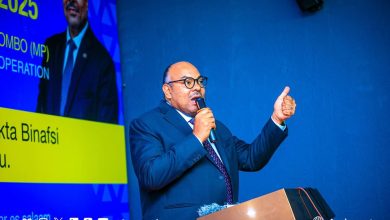Tanzania notches impressive tourism growth

DAR ES SALAAM: AS Tanzania celebrates 63 years of independence, the country has continued to record tremendous success in tourism sector, heading closer to attaining the target of 5 million tourists by 2025.
According to fresh data from the Bank of Tanzania (BoT), as of August this year, the country welcomed over two million international tourists, generating an unprecedented 3.5 billion US dollars in revenue.
This economic boon has significantly contributed to Tanzania’s GDP, with tourism now accounting for 17.2 per cent of the national GDP and 29 per of Zanzibar’s GDP.
To signify the country’s notable growth in tourism sector, Tanzania once again claimed its crown as the World’s Leading Travel Destination, solidifying its position as a global tourism powerhouse.
This prestigious accolade, awarded by the World Travel Awards, marks the second consecutive year that Tanzania has earned this recognition.
A key factor contributing to this achievement is the visionary leadership of President Samia Suluhu Hassan and her strategic initiatives, including the highly acclaimed “Royal Tour” film, that have significantly elevated Tanzania’s global profile.
The film, produced in collaboration with renowned filmmaker Peter Greenberg, offers a captivating glimpse into the country’s diverse landscapes, rich cultural heritage, spectacular wildlife and warm hospitality.
The “Royal Tour” has not only captivated audiences worldwide but has also had a tangible impact on Tanzania’s tourism industry.
By showcasing the country’s stunning natural wonders, such as the Serengeti National Park, Ngorongoro Crater and Mount Kilimanjaro, the film has inspired countless travellers to explore Tanzania’s breathtaking destinations.
In fact, the country leads in tourism services exports, contributing more than half of the region’s export earnings with 3.4 billion US dollars (about 8.97tri/-) last year, up from 2.6 billion US dollars (about 6.86tri/-) in 2019 among East African countries.
Speaking recently in Dar es Salaam when highlighting the 2nd edition of the East African Business Council (EABC) Barometer on Trade in Services in the East African Community (EAC) launched in September this year, the EABC Acting Executive Director, Mr Adrian Njau said that Tanzania is on the right track in tourism growth.
“This growth for Tanzania and the region highlights tourism’s vital role in generating foreign exchange, creating jobs and driving infrastructure development,” he said.
As a key source of revenue, tourism helps diversify region’s economy, reducing reliance on traditional sectors like agriculture and mining, and strengthening its regional economic standing.
Mr Njau said Tanzania is also the leading importer of tourism services at 394.2 million US dollars (1.04tri/-), a decrease from 651.5 million US dollars (1.72tri/-) in 2019.
The region as whole, he noted, exported travel services worth 6.3 billion US dollars (16.62tri/-) last year against 1.2 billion US dollars (3.16tri/-) imports.
The workshop focused on two sectors namely tourism and travel related services and transport services due to their significance to EAC economies.
He said that Tanzania dominates export of transport services with 2.4 billion US dollars (6.33tri/-), which is about 52 per cent of EAC exports against Kenya’s 1.8 billion US dollars (4.74tri/-), which is 39 per cent of total EAC exports.
“Tanzania potential for export of transport services is immeasurable as is landlinked to other eight countries of which most of them are land locked countries,” he stated.
The countries are namely Burundi, Rwanda, the Democratic Republic of the Congo (DRC), Malawi, Zambia, Mozambique and Kenya.
Last year (2023), the international television-CNN through its travel page has helped travellers across the world make choices of where to visit by mentioning Tanzania as among the 23 best destinations to visit.
Tourism accounts for more than 17 per cent of Gross Domestic Product (GDP) and 25 per cent of foreign earnings.
The sector possesses significant potential to contribute to the national economy and foreign receipts on account of the unique natural attractions present in the country relative to elsewhere on the continent.
The tourist attractions present in the country include national parks and game reserves, plants, mountains, valleys, waterfalls and coastal areas.
ALSO READ: Tanzania tops EAC in tourism exports earnings
Tanzania seeks to achieve the target of notching an income of 6 billion US dollars (about 14tri/-) from 5,000,000 tourists come 2025 as stipulated in the Third Five-Year Development Plan (FYDP III of 2020/2021 to 2025/2026) and the ruling party CCM Election Manifesto of 2020-2025.
To promote sector competitiveness and linkages, FYDP III is prioritising the development and implementation of a clear tourism legal and regulatory framework and strengthening public-private dialogue and collaboration.
Key interventions include to promote new tourism products development and diversification for sustainable growth and to promote southern tourist circuit as alternative to other circuits. And, these efforts are beginning to pay off.
The resurgence in tourism growth reflects both the intrinsic allure of Tanzania’s natural and cultural assets and the efficacy of President Samia’s forward-thinking promotional strategies.
For many, President Samia’s committed initiatives have not only led Tanzania to be recognised as a leader in global tourism but also have rejuvenated its economy post-pandemic.
Her leadership exemplifies how strategic vision, when coupled with cultural pride and an openness to innovation, can drive national success in the global arena.
“As Tanzania continues to capitalise on its newfound acclaim, the continued collaboration between government, private sector stakeholders and local communities will be vital to sustaining this momentum and ensuring lasting prosperity in the tourism industry,” said a seasoned tourism expert, Mr Sirili Akko.
“Many factors have contributed (to rising number of tourist arrivals). One is pre-Covid bookings. Some of the visitors are those who made bookings before Covid-19 and, of course, aggressive marketing led by President Samia Suluhu Hassan,” Mr Akko said.
“It should also be noted that we’re in high season and many tourists prefer to visit Tanzania during this time,” he said mid this year.
Mr Akko said he was optimistic that the number of tourists would continue to increase and Tanzania can meet the 6 billion US dollars annual revenue earning target in 2025 from five million tourists if measures to improve the business environment as well as strong marketing campaigns will be sustained.
He said the target could be attained if there will be no global economic hardship that will affect the sector.
“The target can be reached subject to how we are going to sustain improvements in business environment and marketing initiatives and if there will be no global economic hardships,” he said.
The good thing is that for the past few years, there has been significant increase in the number of domestic tourists, who have developed a culture of sampling various local destinations.





